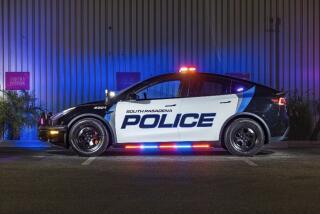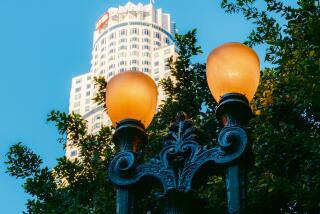Time to Cast Brighter Light on Street Safety : Security: Low-pressure sodium lights, which create an eerie and foreboding mood, should be changed to the whiter, high-pressure sodium variety.
- Share via
To date, the city of San Diego’s Redevelopment Agency has invested $152 million in downtown revitalization. But the city is putting that investment at risk unless it changes its street-lighting policy, and replaces the yellow-cast, low-pressure sodium lights downtown with whiter lights.
The redevelopment program calls for an active, 24-hour city--where San Diegans can live, work and spend their leisure time--day and night. Proper lighting is a critical element in creating an exciting, festive and safe nighttime environment, which invites business patrons, tourists, residents and employees to come or stay downtown after dark.
What is the problem with low-pressure sodium lights? LPS cannot reflect color. When LPS is the only light source, there is no color. On a standard color rendition scale of 1 to 100, low-pressure sodium light yields a minus 44; every object under LPS lighting is a hue of gray, including banners, clothing, cars, parks and historic buildings, resulting in a colorless street scene. Even painted curbs are gray, which causes motorists to get tickets for parking in restricted zones. In LPS light, people look as though they’ve climbed from a crypt.
When you cannot discern color, you cannot “see.” Your brain is saying, “What’s wrong with this picture?” A recent news item is telling. A newspaper reported, “(Police) officers were looking for a dark gray or black Toyota sedan that was last seen by witnesses traveling east on Market.” The police know that the car could have been green, blue, red--any dark color. The witnesses could only report what they saw--a gray or black car.
Downtown is everyone’s Main Street. It is our regional gathering place. Downtown is also the hub of the county’s transportation system: Lindbergh Field, San Diego Trolley, Santa Fe Depot/Amtrak, the Greyhound Bus Station, San Diego Transit, California 163, Interstate 5 and the cruise ship terminal. Anyone using one of these modes of transportation downtown at night is greeted by the eerie and foreboding mood created by LPS street lighting.
San Diego is one of a handful of cities that have opted for low-pressure sodium street lighting. But even the few who have recognize the importance of lighting to a downtown’s vitality. For example, the city of Long Beach in the late 1970s converted to LPS to conserve energy. Safety concerns have now prompted the city to allow some conversions away from LPS street lighting. Its downtown, known for many years as the “black hole,” due to its yellow lights, was recently converted to high-pressure sodium lighting (which has a color rendition rating of plus-21).
The city of San Jose exempted its downtown from LPS street lighting, while requiring it everywhere else in deference to Mount Hamilton Observatory. San Diego’s center city is more than 40 miles from the Mt. Palomar and Mt. Laguna observatories; this distance means that downtown’s street lighting has no scientific impact on the observatories.
The street-light discussion has been characterized by contradictions. For example, although San Diego State University has supported LPS lighting throughout the city because of its Mt. Laguna Observatory, one does not find LPS lighting on its campus. SDSU’s decision to not use LPS is based on safety concerns, specifically the increase several years ago of on-campus rapes, car break-ins and thefts. Low-pressure sodium lighting is rejected for public parking areas for safety and aesthetic reasons. With no color differentiation, finding your car in a crowded lot is an impossible task.
The estimate to convert the entire city back to high-pressure sodium lights is a one-time cost of $3.5 million to $4 million. The city’s estimate of the difference in on-going operating and maintenance costs is that HPS street lighting may cost $400,000 more per year citywide. However, technical experts have said that those operating cost differentials are actually much less (or even negligible), when one accounts for the difference in the life-cycle operation of the lights and when it is acknowledged that a high-pressure sodium lamp throws a wider light (lights more of the street surface) than a low-pressure sodium lamp.
To convert just the center city would be significantly less costly. And the on-going expense (and perhaps some or all of the conversion expense) would be borne by the Centre City Street Lighting Assessment Districts.
For all these reasons, Centre City Development Corp. has joined 10 other major downtown organizations in supporting the conversion of center city’s street lights to the whiter, high-pressure sodium lights.
More to Read
Sign up for Essential California
The most important California stories and recommendations in your inbox every morning.
You may occasionally receive promotional content from the Los Angeles Times.













